Oh Apple Where Art Thou?
April/12/14 15:26 Filed in: Apple
On more than a couple of occasions wandering the halls of NAB this year, I heard comments from random passers-by along the lines of, “WHY can't Apple BE here? I mean how hard is it?”
I have to agree with them. One of the largest companies in the world, sitting on $159 BILLION in CASH, fer Jimminy Cricket, and they can't break off a tiny fractional piece o’ that to come to NAB, set up a modest booth and show off their stuff. Not to mention give the faithful users some swag.
Believe me, I understand why they have opted not to come to the show - they can get an audience of 100M of their peeps via their tightly controlled shows on their website, vs. 100k via NAB. When you get this big, it’s all about the percentages. And this is exactly the issue - they are showing their MicroSoftiness, their not-hungry, beaner-centric approach. Unlike Blackmagic and Atomos, they now only talk about upcoming products via their own TV channel. But I have to say that this particular 100,000 people talk to all the other people that use Apple products. Do the math.
I would think that they could send a few geniuses and some hardware and software to show those of us who use and love their products (and spent time and money to come to Vegas), that they are AT LEAST thinking about us. They're still producing some really nice hardware and software — but the Blackmagics of the world are taking over the wow factor that Steve used to give us in their product launches. I dunno about you, but I feel more connected to, and excited by, Blackmagic than Apple now. Which makes me happy for BM and sad about Apple.
I expect it's quite possible that Steve himself would approve of not "wasting" money on NAB. But the other side of that coin is that their continuing absence is engendering bad feelings toward the company that didn't exist before.
I have to agree with them. One of the largest companies in the world, sitting on $159 BILLION in CASH, fer Jimminy Cricket, and they can't break off a tiny fractional piece o’ that to come to NAB, set up a modest booth and show off their stuff. Not to mention give the faithful users some swag.
Believe me, I understand why they have opted not to come to the show - they can get an audience of 100M of their peeps via their tightly controlled shows on their website, vs. 100k via NAB. When you get this big, it’s all about the percentages. And this is exactly the issue - they are showing their MicroSoftiness, their not-hungry, beaner-centric approach. Unlike Blackmagic and Atomos, they now only talk about upcoming products via their own TV channel. But I have to say that this particular 100,000 people talk to all the other people that use Apple products. Do the math.
I would think that they could send a few geniuses and some hardware and software to show those of us who use and love their products (and spent time and money to come to Vegas), that they are AT LEAST thinking about us. They're still producing some really nice hardware and software — but the Blackmagics of the world are taking over the wow factor that Steve used to give us in their product launches. I dunno about you, but I feel more connected to, and excited by, Blackmagic than Apple now. Which makes me happy for BM and sad about Apple.
I expect it's quite possible that Steve himself would approve of not "wasting" money on NAB. But the other side of that coin is that their continuing absence is engendering bad feelings toward the company that didn't exist before.
Comments
NAB Day 1 - AJA CION
April/07/14 17:07 Filed in: Video Cameras
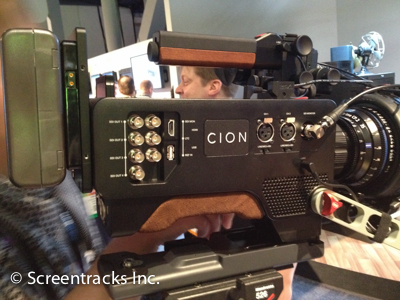
Great minds think alike - AJA comes out with their 4k, PL-mount CION (pronounced scion) as in “scion of an old family”.
With a 4k APS-C sized CMOS global shutter sensor recording full 4k or UHD at 60p, as well as hardware-scaled 2k and 1080, to AJA’s SSD Pak storage units. These are available in 256GB or 512GB sizes, and as such the cost per GB will be considerably less, methinks, than the BM URSA. It is also more shoulder-friendly than the URSA, as it is about half the weight and size, and has a nice cushy leather pad built in.
It may be lighter, smaller and have less expensive media than the URSA, but it is slated to cost about 50% more - $9,000.
One of the nice features is a mechanical back focus adjustment which is accessed via a panel on top.
NAB Day 1 - Blackmagic URSA
April/07/14 16:40 Filed in: Video Cameras
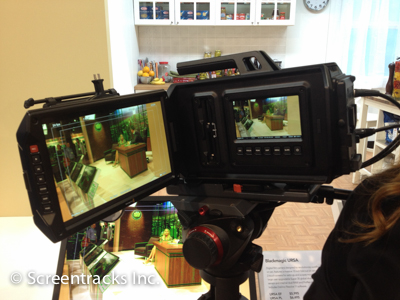
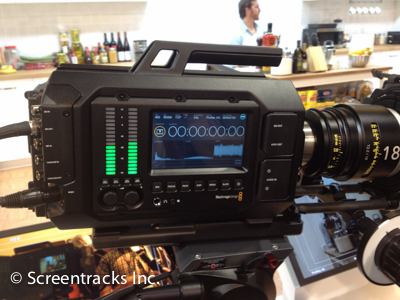
Happened to walk right in the door by Blackmagic after reading Grant Petty’s email announcement of this year’s slew of schtuff. The green tints on the monitors in the first image is due to focus enhancement being on.
The URSA is a large, 15-lb. upgradeable body that comes in several lens mount flavors, sports a Super 35 global shutter 4k imager, a 10” side screen on the left side, and a 5” screen on the right side for setting, status and scopes. It will record Cinema DNG RAW and ProRes 4k to two CFast card slots, currently a spendy proposition, with cards like SanDisk’s 120GB CFast 2.0, which currently go for about $1,200 each. And 120GB doesn’t get you a whole lot of time at RAW or ProRes 4k rates.
It ships 4k 60p capable, but will be upgradeable to 120fps. The imager will be upgradeable as well. The first two units, the URSA EF and URSA PL (referring to their lens mount types) are slated to show “around July” for $5,995 and $6,495 respectively.
Pono Player
April/05/14 17:53 Filed in: Audio
It is, at the very least, the winner for the most beautifully marketed personal music player in existence, and possibly the new template for Kickstarter campaigns. Doesn’t hurt the experience to have Neil Young invite you backstage into his custom Caddy to experience hi-res playback of classic rock and soul. The Pono Player (pono is Hawaiian for “righteous”) sure looks like a winner, at least going by the endorsements of both major rock stars and random teenagers.
As a gear slut from way back, I couldn't help but be swayed, and signed up as a Kickstarter sponsor in order to get a first-generation player, due to come out in October. Neil has been on this mission for quite a while now, and frankly it is great to see his vision of high-end music for the masses coming to fruition.
As such this ends up being a must see at this month’s Axpona show in Chicago.
As a gear slut from way back, I couldn't help but be swayed, and signed up as a Kickstarter sponsor in order to get a first-generation player, due to come out in October. Neil has been on this mission for quite a while now, and frankly it is great to see his vision of high-end music for the masses coming to fruition.
As such this ends up being a must see at this month’s Axpona show in Chicago.
Last DSLR Joke (maybe)
March/25/14 10:40 Filed in: Video Cameras
Well, I was going to stop ridiculing DSLRs as video cameras, because I figure that's just about over - (the ability, in good conscience, to give them crap) since any day now DSLRs should fully morph into ‘real’ video cameras.
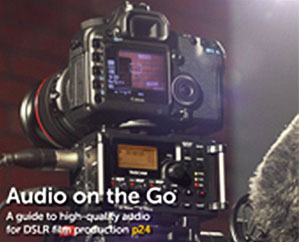
But then I open my e-mail this morning and I see this picture on the cover of Audiomedia. This is the kind of thing that kills me. DSLRs are so awesome!* But if you want to record decent quality video, you need an external recorder. And if you want to record decent quality audio, you need an external recorder. And if you want all this stuff to function together as a unit, you need some sort of rig.
Now admittedly, I'm going around with an Atomos Samurai hanging off of my camera rails, which has extended the life of my EX-1, so in a sense I don't have a leg to stand on. But I'm a big believer in fully functional camcorders, particularly in the real world of live and corporate and running gun.
I remember the days when ‘tape operator’ was a separate job because the recorder was so heavy it required a second person to carry and operate it. But for a long time now you have been able to get cameras with good optics, good codecs, a fully functional zoom lens, and reasonable ergonomics at a reasonable price. Heck, some of those BetaCam rigs used to cost more than a luxury car.
So this return to separate imaging devices with external video and audio recording devices cracks me up. I suppose if you are shooting Cine-style, it harkens back to shooting film with audio recording on a Nagra. But I mean seriously, that's as if you had a film camera, but had to have a separate film recorder external to the camera!
Don't get me wrong, I'm actually excited about where all this is headed. I love this point in a technology, where you see something new evolving, and you are not entirely sure what it is going to become.
So let me have my last 10 minutes of fun.
*Don't give me a hard time about this joking statement. I know, they are actually awesome.

But then I open my e-mail this morning and I see this picture on the cover of Audiomedia. This is the kind of thing that kills me. DSLRs are so awesome!* But if you want to record decent quality video, you need an external recorder. And if you want to record decent quality audio, you need an external recorder. And if you want all this stuff to function together as a unit, you need some sort of rig.
Now admittedly, I'm going around with an Atomos Samurai hanging off of my camera rails, which has extended the life of my EX-1, so in a sense I don't have a leg to stand on. But I'm a big believer in fully functional camcorders, particularly in the real world of live and corporate and running gun.
I remember the days when ‘tape operator’ was a separate job because the recorder was so heavy it required a second person to carry and operate it. But for a long time now you have been able to get cameras with good optics, good codecs, a fully functional zoom lens, and reasonable ergonomics at a reasonable price. Heck, some of those BetaCam rigs used to cost more than a luxury car.
So this return to separate imaging devices with external video and audio recording devices cracks me up. I suppose if you are shooting Cine-style, it harkens back to shooting film with audio recording on a Nagra. But I mean seriously, that's as if you had a film camera, but had to have a separate film recorder external to the camera!
Don't get me wrong, I'm actually excited about where all this is headed. I love this point in a technology, where you see something new evolving, and you are not entirely sure what it is going to become.
So let me have my last 10 minutes of fun.
*Don't give me a hard time about this joking statement. I know, they are actually awesome.
Canon 1DC and Panasonic GH4 - They're Almost Video Cameras!
March/06/14 11:20 Filed in: Video Cameras
The thing that's killing me about this new crop of cameras is that we are getting to the point where a given DSLRs’ video performance is exceeding its still picture performance.
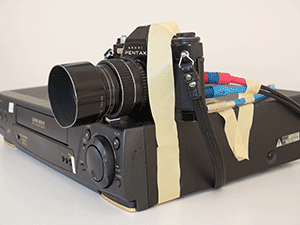
Yep - this is my new Pentaxasonic VHS DSLR. Both the rig and the footage from it have a nice “retro high end” look. It rests on the shoulder pretty well, and grabbing the far side makes for a stable platform. This weekend though, I think I’ll take the feet off the VCR and screw the butterfly handlebars from my Schwinn upside-down into the bottom. It’ll be retro-bitchin’. The drawback to this rig is that you do need a really long extension cord for powering the VCR. I have a team working on a car battery adaptor and tray for it that fits underneath – balances the rig out pretty well.
I thought I would get this product out there on the market before sub-$10k DSLRs really do turn into video cameras. Wouldn’t be surprised if there’s one or two at NAB 2014 next month. Of course, I’ve been expecting that for a while now.
I admit sometimes I can’t figure out why “the DSLR revolution” irks me so much. I guess I come from the olden times when cameras were cameras, and you knew what was still and what moved, and the twain did not meet.
Used to be that video-capable DSLRs were always very good still cameras, so you could forgive some of the video shortcomings - but now some reports and imagery from the 1DC and GH4 suggest they are somewhat underwhelming as still cameras at their given price points. The ironic thing is that they are still lacking major functionality features of video cameras. So still not quite fish or fowl.
I get the appeal of DSLRs - they can take big, fat, high-resolution, big pixel images with easily limited depth of field, yielding a filmic look. If you own lenses that fit on them, you’re half kitted out already. If you are a still photographer, you can move into videography with minimal investment.
Yet most have been hobbled by crap codecs - a bit like recording a very nice lens and sensor to VHS tape - as well as functionality limits which, if missing from a pro camcorder, would get you laughed out of the room (and no sales). You need to spend an average of one to two times the cost of most DSLRs on ancillary gear to make it simulate a pro video camera’s functionality.
The GH4 is taking the step of offering some of that functionality in a $2k add-on box. So you’re at around $3,700 for something approaching a video camera. And the 1DC? $10k for the body alone. You can get some nice camcorders with a fully functional zoom lens for that.
Yet they continue to grow in popularity. I’ve noticed more and more recent online freelance job solicitations specifying the desire for DSLRs and DSLR experience. Do you want to place any bets on how many of those client-side folk have any idea why they are asking for it? (Bob in accounting has one.) And none of those same folks were specifying the type of HD camera they wanted prior to the DSLR revolution.
But you know what? It doesn’t matter! Never really has. It’s not about the gear. It’s what you point it at. Not that we’re going to stop talking about the gear…

Yep - this is my new Pentaxasonic VHS DSLR. Both the rig and the footage from it have a nice “retro high end” look. It rests on the shoulder pretty well, and grabbing the far side makes for a stable platform. This weekend though, I think I’ll take the feet off the VCR and screw the butterfly handlebars from my Schwinn upside-down into the bottom. It’ll be retro-bitchin’. The drawback to this rig is that you do need a really long extension cord for powering the VCR. I have a team working on a car battery adaptor and tray for it that fits underneath – balances the rig out pretty well.
I thought I would get this product out there on the market before sub-$10k DSLRs really do turn into video cameras. Wouldn’t be surprised if there’s one or two at NAB 2014 next month. Of course, I’ve been expecting that for a while now.
I admit sometimes I can’t figure out why “the DSLR revolution” irks me so much. I guess I come from the olden times when cameras were cameras, and you knew what was still and what moved, and the twain did not meet.
Used to be that video-capable DSLRs were always very good still cameras, so you could forgive some of the video shortcomings - but now some reports and imagery from the 1DC and GH4 suggest they are somewhat underwhelming as still cameras at their given price points. The ironic thing is that they are still lacking major functionality features of video cameras. So still not quite fish or fowl.
I get the appeal of DSLRs - they can take big, fat, high-resolution, big pixel images with easily limited depth of field, yielding a filmic look. If you own lenses that fit on them, you’re half kitted out already. If you are a still photographer, you can move into videography with minimal investment.
Yet most have been hobbled by crap codecs - a bit like recording a very nice lens and sensor to VHS tape - as well as functionality limits which, if missing from a pro camcorder, would get you laughed out of the room (and no sales). You need to spend an average of one to two times the cost of most DSLRs on ancillary gear to make it simulate a pro video camera’s functionality.
The GH4 is taking the step of offering some of that functionality in a $2k add-on box. So you’re at around $3,700 for something approaching a video camera. And the 1DC? $10k for the body alone. You can get some nice camcorders with a fully functional zoom lens for that.
Yet they continue to grow in popularity. I’ve noticed more and more recent online freelance job solicitations specifying the desire for DSLRs and DSLR experience. Do you want to place any bets on how many of those client-side folk have any idea why they are asking for it? (Bob in accounting has one.) And none of those same folks were specifying the type of HD camera they wanted prior to the DSLR revolution.
But you know what? It doesn’t matter! Never really has. It’s not about the gear. It’s what you point it at. Not that we’re going to stop talking about the gear…
Korg DS-DAC 100
February/08/14 11:38 Filed in: Audio
A reasonably priced DSD DAC from a pro equipment manufacturer with lots of output options
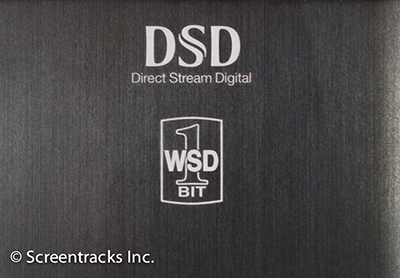
The KORG DS-DAC 100 looks like a good idea - it’s what most people would want; headphone out, RCA and XLR out. Been using Korg Audiogate software for years; it’s not as pretty and full-featured of a user interface as other software players that play DSD files, but it’s very straightforward and does all manner of conversions. After all, it was designed more as a tool for people recording original DSD files rather than a means of home-user playback.
At $600, it looks like a good price point (at the moment) for having the full choice of outputs. I currently have the Resonessence Labs Herus (around $400), which only has a headphone output (it’s sort of a “DSD Dragonfly”) but it has high enough output to drive Sennheiser HD 600 headphones (moderately hard to drive) and I have connected it with a Y cable to my receiver with good results. The Herus utilizes the ESS Sabre DAC chip - ES9010-2M. Not sure if it sounds as good as playback from the Korg MR-1000, but that’s a test we could do. Hard to compare when you’re sticking totally different types of interconnects between source and amp. I haven’t set up any kind of optimized computer playback for DSD either - I just ran it off my old MacBook Pro (USB 2).
I have owned the Korg MR-1000 for a few years now, and I’ve felt DSD was a superior-sounding format to PCM since I first had a Sony 777ES SACD player, which is why I got the Korg for transferring albums to digital. It just captures more information in a natural way, to my ears. Having said that, in the years between, PCM recording and playback has improved immensely. My ARCAM DV-139 player played back high bitrate PCM (via DVD-audio) stunningly. The Oppos also do a fab job with PCM. Neither of them sound quite right playing back SACD/DSD though, compared to Sonys.
I’m not sure converting anything is a good idea, if it’s already digital. I generally feel that “good” (insert your sample-and-bitrate here) NATIVE recording and playback is the way to go. In other words, if you already have a well-recorded and properly-converted-to-(insert your sample-and-bitrate here) file, then a good playback chain for doing that type of file should be good.
Of course, there are lots of types of files, so the Sony HAP-Z1ES (the name even looks “happy”) type of device should be the future. Even us techno-audiophiles can get tired of all of the farting around necessary to make stuff play back properly.
As for the work involved in properly digitizing vinyl - it’s still godforsakenly labor-intensive. Audiogate makes it fairly easy to chop a side into tracks, but you still have to do it, one way or another. Then there’s the whole thing of changing or improving some aspect of your playback chain - which then makes you want to re-record everything you’ve already done. SO MANY variables in the vinyl reproduction chain!

The KORG DS-DAC 100 looks like a good idea - it’s what most people would want; headphone out, RCA and XLR out. Been using Korg Audiogate software for years; it’s not as pretty and full-featured of a user interface as other software players that play DSD files, but it’s very straightforward and does all manner of conversions. After all, it was designed more as a tool for people recording original DSD files rather than a means of home-user playback.
At $600, it looks like a good price point (at the moment) for having the full choice of outputs. I currently have the Resonessence Labs Herus (around $400), which only has a headphone output (it’s sort of a “DSD Dragonfly”) but it has high enough output to drive Sennheiser HD 600 headphones (moderately hard to drive) and I have connected it with a Y cable to my receiver with good results. The Herus utilizes the ESS Sabre DAC chip - ES9010-2M. Not sure if it sounds as good as playback from the Korg MR-1000, but that’s a test we could do. Hard to compare when you’re sticking totally different types of interconnects between source and amp. I haven’t set up any kind of optimized computer playback for DSD either - I just ran it off my old MacBook Pro (USB 2).
I have owned the Korg MR-1000 for a few years now, and I’ve felt DSD was a superior-sounding format to PCM since I first had a Sony 777ES SACD player, which is why I got the Korg for transferring albums to digital. It just captures more information in a natural way, to my ears. Having said that, in the years between, PCM recording and playback has improved immensely. My ARCAM DV-139 player played back high bitrate PCM (via DVD-audio) stunningly. The Oppos also do a fab job with PCM. Neither of them sound quite right playing back SACD/DSD though, compared to Sonys.
I’m not sure converting anything is a good idea, if it’s already digital. I generally feel that “good” (insert your sample-and-bitrate here) NATIVE recording and playback is the way to go. In other words, if you already have a well-recorded and properly-converted-to-(insert your sample-and-bitrate here) file, then a good playback chain for doing that type of file should be good.
Of course, there are lots of types of files, so the Sony HAP-Z1ES (the name even looks “happy”) type of device should be the future. Even us techno-audiophiles can get tired of all of the farting around necessary to make stuff play back properly.
As for the work involved in properly digitizing vinyl - it’s still godforsakenly labor-intensive. Audiogate makes it fairly easy to chop a side into tracks, but you still have to do it, one way or another. Then there’s the whole thing of changing or improving some aspect of your playback chain - which then makes you want to re-record everything you’ve already done. SO MANY variables in the vinyl reproduction chain!
The Four Songs EP Story
October/10/13 11:42 Filed in: Audio
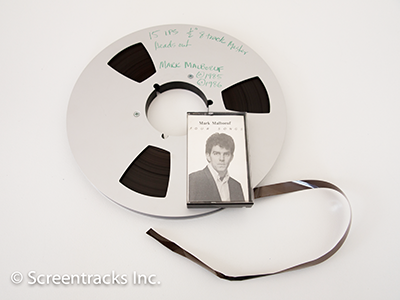
The devilishly-cleverly-titled “Four Songs” EP was recorded in 1986 at Al Nalli Annex in Ann Arbor Michigan. It was a studio in the basement of that excellent musical equipment store, and as such they had nice gear in excellent condition. I had been working on these originals with drummer Donn Deniston and fellow bandmate John Spires as a trio side-project from our working bar band.
For the recording, Donn was drummer & recording engineer, and I wrote, played and sang everything else. It was recorded on ½” 8-track. No, not one of those eight tracks - the kind in the florescent green plastic sandwich-sized box, that you shoved into a dash-mounted player in your car. This, my children, was a half inch reel to reel from the ancient pre-digital, pre-internet times, and despite not being a 24 track it had fairly serious fidelity. Actually track width and tape speed were (and are) larger determinants of fidelity than the number or tracks. If you divide the 2” width of standard 24-track tape by 24, the result isn’t that far from ½” divided by 8 tracks.
Post production mix at The Old Schoolhouse with Pete Bankert of Rock City Studio - www.rockcitystudio.com.
The resulting cassette(!) was sent via Rob Nalli to Foghat’s peeps, who passed on it, as the 15 minutes of the “Rockabilly Revival” of the time had passed. Guess I was just ahead of my time.
In order to digitally remaster the material, I was surprised to find it harder than expected to get my hands on a half-inch 8-track recorder. Thankfully there is a local keeper of the analog flame, Steve Albini - perhaps best known for recording Nirvana’s “In Utero” album, (which was re-released in 2013 for its 20th anniversary). Not to mention member of Big Black and Shellac.
Steve’s studio in Chicago, Electrical Audio - www.electricalaudio.com has an awesome collection of analog machines. Resurrected from the vaults, I brought in the 8-track and ¼” 2-track masters, where they were slowly and lovingly baked in a low oven to help prevent shedding and were then transferred to digital at 24/88.2.
These aren’t exactly hi-fi recordings (by modern standards) in terms of the sounds we put into the board, but ½” 8-track analog is a marvelously elastic and wide-bandwidth format, (even by modern standards). The drums and mics were good (sorry – can’t recall what they were) but most importantly were played by a guy who could play, man. The guitar and bass were Fenders, running through the then-ubiquitous Scholz Rockman. Between that and the big, gated reverb on the drums, the sound fairly screams, “that’s 80’s baby!”. Not namby-pamby.
I hope to have the time to monkey with them some more in the near future. Donn wasn’t satisfied at the time with the lone drum groove throughout “I Give My Heart”, and drum replacement technology has grown exponentially since then. Any paid downloads will include updates to future versions. Let me know if you have any interest in downloading a high-res version and I’ll post it.
4K Camera News
September/24/13 12:08 Filed in: Video Cameras
The new Sony 4k PXW-Z100 and FDR-AX1 4k cameras
Here's a clip from Alister Chapman at IBC about the new Sony 4k PXW-Z100 camera - and at about 2:30 they talk about why you would use the PMW-200 over this jobber!
http://www.newsshooter.com/2013/09/13/ibc-2013-sony-pxw-z100-and-fdr-ax1-4k-cameras/
So don't feel so bad! You probably have a better camera! Unless you have client clamoring for 4k…..
But seriously, 4k on a less-than-half -inch chip!? I notice all the demo shots are wide, because if they shot close you would see how video-y it will look. Still, pretty cool.
What I have been imagining is a camera like the EX3 with (3) 4k chips, or one big one. Been looking again at the FS-700, as they have enabled the 4K capability on that, and it looks pretty. Super 35mm sensor as in the F5 and F55.
A quick way to explain the Bayer sensor deal (almost all of these large single-chip cameras nowadays are Bayer sensors) is:
"One thing to remember is that because of the nature of a Bayer sensor you need the sensor to have a higher pixel count than the final desired resolution. Typically you want at least 30% more pixels than your target resolution. As a minimum for good 1080 you want around 2.5K-2.7K pixels."
That's also from Alister Chapman, a cameraman/blogger who knows his stuff. So when the REDs of the world are bragging on their latest mega-mega-pixel sensor, you have to ask, "how many REAL pixels is that?"
Here's a clip from Alister Chapman at IBC about the new Sony 4k PXW-Z100 camera - and at about 2:30 they talk about why you would use the PMW-200 over this jobber!
http://www.newsshooter.com/2013/09/13/ibc-2013-sony-pxw-z100-and-fdr-ax1-4k-cameras/
So don't feel so bad! You probably have a better camera! Unless you have client clamoring for 4k…..
But seriously, 4k on a less-than-half -inch chip!? I notice all the demo shots are wide, because if they shot close you would see how video-y it will look. Still, pretty cool.
What I have been imagining is a camera like the EX3 with (3) 4k chips, or one big one. Been looking again at the FS-700, as they have enabled the 4K capability on that, and it looks pretty. Super 35mm sensor as in the F5 and F55.
A quick way to explain the Bayer sensor deal (almost all of these large single-chip cameras nowadays are Bayer sensors) is:
"One thing to remember is that because of the nature of a Bayer sensor you need the sensor to have a higher pixel count than the final desired resolution. Typically you want at least 30% more pixels than your target resolution. As a minimum for good 1080 you want around 2.5K-2.7K pixels."
That's also from Alister Chapman, a cameraman/blogger who knows his stuff. So when the REDs of the world are bragging on their latest mega-mega-pixel sensor, you have to ask, "how many REAL pixels is that?"
Arri Amira - We Don' Need No Stinking 4K!
September/19/13 12:02 Filed in: Video Cameras
Yeah - no way I could afford it either - but it's pretty!
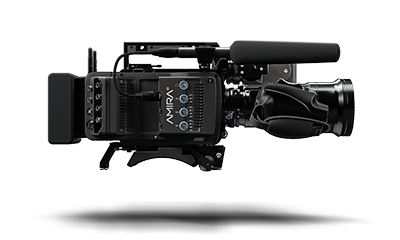
http://www.arri.com/amira/
The major thing is THEY BUILT A CAMERA THAT YOU CAN PICK UP AND SHOOT WITH like normal cams of yore! Did you see the adjustable shoulder rest and eyepiece?! Don't need an effing cage with crap bolted all over it! AND FULL QUALITY 200fps! Yowza indeed.
They have some over-the-top grading on the showreel stuff, but I generally like the look of Alexa-stuff over RED. Haven't ever really cared for the look of a lot RED footage - it seems to have a “hardness” that doesn’t appeal to me. Still like the look of Sony stuff though - guess I'm a traditionalist. They get slammed a lot for being excessively red-tinted by people who like the green-leaning look of Ikegami (if they're old like some of us) or the "moody" green grades you see in movies these days.
Still hope to one day either be able to afford (have jobs for) an F3, or maybe an FS-700. I keep thinking (thought the new EX-3 upgrade, the PMW-300 was going to be it - but it ain't) they're going to combine an EX-style camera with an F3-type sensor and such.
Good article on trying to make sense of sensor size and crop factor:
http://www.lensrentals.com/blog/2012/01/sensor-size-matters-part-1
It's skewed toward still cameras a bit, but overlaps video a fair amount. Haven't read the whole thing (makes my head hurt), but so far he's left out the whole 3-chip vs. 1-chip deal, which a lot of talk about sensor size tends to do. Read up on "de-Bayering" - what 1 chip large sensor cameras have to do to make 3 colors. You have to get up into the F5 kind of money, I believe, before you get into a camera that doesn't have to do a bunch of computational magic to simulate 3 colors (unlike traditional 3-chip cameras). But most people don't care or know about that. Big sensors do have a number of benefits that outweigh the negatives - particularly for people that don't ever have to deal with the technical issues!
The other big thing about most of these cameras is that you are typically looking at an investment of 1-2 times the cost of the camera body to fit it out with lens(es) and ancillary gear needed to make it function like a normal, full-on camcorder. Hence you have all these still photographers that led the charge into DSLR video, since they already had a significant investment in camera lenses.
Even with the Blackmagic Pocket Cinema Camera (around $1k), you kinda want a good all-around lens with Image Stabilization, etc. which is going to run you more than $1k -- then you need a boatload of spare batteries (they only last ½ hour) and high-end memory cards, blah blah. And it's only "Super 16" size (smaller than full 16).
Speaking of the BMPCC - this is a kinda nice piece shot on it, from Philip Bloom - though largely due to the light and the subject. If you were standing next to him with your camera (what ever it may be), you would have gotten some really nice footage as well.
https://vimeo.com/72996911
He did a lot of post on it with FilmConvert, etc.
http://philipbloom.net/2013/08/27/pocketcamera/

http://www.arri.com/amira/
The major thing is THEY BUILT A CAMERA THAT YOU CAN PICK UP AND SHOOT WITH like normal cams of yore! Did you see the adjustable shoulder rest and eyepiece?! Don't need an effing cage with crap bolted all over it! AND FULL QUALITY 200fps! Yowza indeed.
They have some over-the-top grading on the showreel stuff, but I generally like the look of Alexa-stuff over RED. Haven't ever really cared for the look of a lot RED footage - it seems to have a “hardness” that doesn’t appeal to me. Still like the look of Sony stuff though - guess I'm a traditionalist. They get slammed a lot for being excessively red-tinted by people who like the green-leaning look of Ikegami (if they're old like some of us) or the "moody" green grades you see in movies these days.
Still hope to one day either be able to afford (have jobs for) an F3, or maybe an FS-700. I keep thinking (thought the new EX-3 upgrade, the PMW-300 was going to be it - but it ain't) they're going to combine an EX-style camera with an F3-type sensor and such.
Good article on trying to make sense of sensor size and crop factor:
http://www.lensrentals.com/blog/2012/01/sensor-size-matters-part-1
It's skewed toward still cameras a bit, but overlaps video a fair amount. Haven't read the whole thing (makes my head hurt), but so far he's left out the whole 3-chip vs. 1-chip deal, which a lot of talk about sensor size tends to do. Read up on "de-Bayering" - what 1 chip large sensor cameras have to do to make 3 colors. You have to get up into the F5 kind of money, I believe, before you get into a camera that doesn't have to do a bunch of computational magic to simulate 3 colors (unlike traditional 3-chip cameras). But most people don't care or know about that. Big sensors do have a number of benefits that outweigh the negatives - particularly for people that don't ever have to deal with the technical issues!
The other big thing about most of these cameras is that you are typically looking at an investment of 1-2 times the cost of the camera body to fit it out with lens(es) and ancillary gear needed to make it function like a normal, full-on camcorder. Hence you have all these still photographers that led the charge into DSLR video, since they already had a significant investment in camera lenses.
Even with the Blackmagic Pocket Cinema Camera (around $1k), you kinda want a good all-around lens with Image Stabilization, etc. which is going to run you more than $1k -- then you need a boatload of spare batteries (they only last ½ hour) and high-end memory cards, blah blah. And it's only "Super 16" size (smaller than full 16).
Speaking of the BMPCC - this is a kinda nice piece shot on it, from Philip Bloom - though largely due to the light and the subject. If you were standing next to him with your camera (what ever it may be), you would have gotten some really nice footage as well.
https://vimeo.com/72996911
He did a lot of post on it with FilmConvert, etc.
http://philipbloom.net/2013/08/27/pocketcamera/
Mac Pro 2
July/02/13 12:12 Filed in: Final Cut Pro X
Remember "the old days" when companies used to just put a product on the market?
I'm getting tired of this teaser stuff. To be fair, Apple has never played this game until now - but what with the Reds and Blackmagics of the world creating future buzz about products that may or may not ship in a year or so - what is a mega corp to do? The kool-aid is wearing off for a lot of folks, but I'm willing to believe until proven otherwise.
I'm breathlessly awaiting the announcement that Tim Cook made last year promising a new Mac Pro (or at least something "really great" to replace it). Should be at the WWDC next month. Some thought sooner.
Meanwhile my 2011 MacBook Pro is working just fine as a desktop. Not ideal, and not really heavy iron, but not bad. Mostly is just lacking I/O that you would get with a tower and cards. I wouldn't buy one now though - wait and see if Apple does something amazing and Steve-like, or if those days are truly over.
It's sort of like with FCPX - it's pretty darn cool, but it's still kinda buggy on occasion, and the initial fast pace of upgrades seems to have slowed. I assume they're tweaking for the MacPro and Mavericks introductions.
It looks pretty much like what people were saying - that it would be incrementally faster than the current Mac Pro. Which, though it's sort of surprising considering the modernity of the device, is not as big of a deal for me (and others stuck using laptops and iMacs) as the dual graphics cards will be.
I'm getting tired of this teaser stuff. To be fair, Apple has never played this game until now - but what with the Reds and Blackmagics of the world creating future buzz about products that may or may not ship in a year or so - what is a mega corp to do? The kool-aid is wearing off for a lot of folks, but I'm willing to believe until proven otherwise.
I'm breathlessly awaiting the announcement that Tim Cook made last year promising a new Mac Pro (or at least something "really great" to replace it). Should be at the WWDC next month. Some thought sooner.
Meanwhile my 2011 MacBook Pro is working just fine as a desktop. Not ideal, and not really heavy iron, but not bad. Mostly is just lacking I/O that you would get with a tower and cards. I wouldn't buy one now though - wait and see if Apple does something amazing and Steve-like, or if those days are truly over.
It's sort of like with FCPX - it's pretty darn cool, but it's still kinda buggy on occasion, and the initial fast pace of upgrades seems to have slowed. I assume they're tweaking for the MacPro and Mavericks introductions.
It looks pretty much like what people were saying - that it would be incrementally faster than the current Mac Pro. Which, though it's sort of surprising considering the modernity of the device, is not as big of a deal for me (and others stuck using laptops and iMacs) as the dual graphics cards will be.
Canon C100
June/26/13 12:16 Filed in: Video Cameras
This thing is starting to get more love out there.
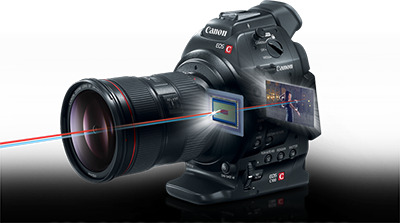
http://www.bhphotovideo.com/bnh/controller/home?O=NavBar&A=getItemDetail&Q=&sku=889545&is=REG&si=rev#costumerReview
Pretty cool, but has its drawbacks. Read the top best & worst reviews. The worst one sums up the issues well. Pretty cool though. I just continue to have the feeling (hope?) that somebody is going to come out with a mashup of the FS700 and this thing, or something like I thought the new EX camera would be - a combo of the usability and functionality of the EX cameras, but with the big sensor and slo-mo of the FS700. I'm guessing/hoping within a year...

http://www.bhphotovideo.com/bnh/controller/home?O=NavBar&A=getItemDetail&Q=&sku=889545&is=REG&si=rev#costumerReview
Pretty cool, but has its drawbacks. Read the top best & worst reviews. The worst one sums up the issues well. Pretty cool though. I just continue to have the feeling (hope?) that somebody is going to come out with a mashup of the FS700 and this thing, or something like I thought the new EX camera would be - a combo of the usability and functionality of the EX cameras, but with the big sensor and slo-mo of the FS700. I'm guessing/hoping within a year...
Sony PMW 300
June/24/13 12:31 Filed in: Video Cameras
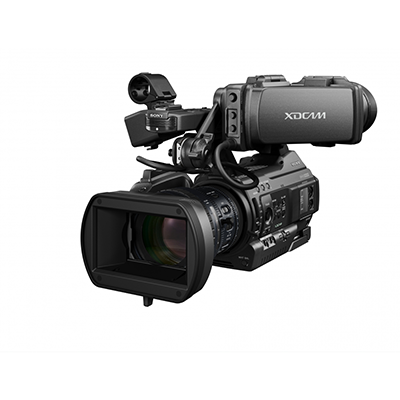
I have a feeling that the new Sony PMW-300:
1) It should be a good solid camera that may have a useful lifespan
2) It's too little too late in some ways
The improvements over the existing EX cameras are incremental. I had frankly hoped for some sort of merging of the EX's with the Fs700 or something along those lines, but I guess the EX-type camera is stuck being a half-inch, three-sensor deal. I've been meaning to do some research on the tradeoffs between 3 chip and the big single chip cameras.
It certainly is nice to have 4:2:2 onboard recording, since regular XDCAM EX is getting long in the tooth, but it's not a huge difference, and I would still use it as simultaneous-record backup. Once you go direct to ProRes, it's pretty hard to go back unless you have to. But for those shooting handheld, and those shooting for Euro broadcast, it certainly makes sense.
The big question mark in my mind is, what will the implementation of the future XAVC codec upgrade be? They are using that codec now in the F5 and F55. Since it already will have 422 50Mbps recording, I'm assuming it will be the 444/ up to 300Mbps flavor. That will likely require buying all new high speed cards to handle the data rate. Plus the rest of the workflow that goes with it - which admittedly is less onerous than much of the 4k & RAW crap that's going on at the moment.
Speaking of which, I've been reading a lot the press and blogs about 4k and RAW, and I really don't see the need for either for a vast majority of shooters - unless you have a client who wants to pay for it, or you want it for your own project. You pay a big price in terms of data rate, cards, hard drives, editing, money, etc. for differences most people can't see. The compressed codecs are just too good for the most part. Hell, I'm still shooting all 720p60, and my clients think it looks awesome. Depends on what you're used to.
The other thing I wonder about XAVC is, being another implementation of H.264, what is its future once H.265 hits the real world? The codec (aka HEVC - high efficiency video codec) has been officially released, and so it should just be a matter of time before it is implemented in cameras and such. H.264 is 10 years old now. H.265 is half the data rate for the same quality (allegedly).
Still cameras for video
January/30/13 12:34 Filed in: Video Cameras
My thought is still to use a video camera for video. Too many hassles and compromises with using still cameras for video.
It's cool if you are a still photographer who has a lot invested in lenses and you want to get into video, but if you're starting from scratch, the extra stuff you need will end up driving the cost up to the level of a dedicated video camera, and then it's not an integrated system.
This is the big problem with this whole trend toward what I might call 'mini-Cine' rigs - there's a lot of stuff and expense aside from the camera head itself. Which is why for most of us, a PMW-type camera is ideal. I mean, unless you really have a NEED for the interchangeable lenses that you get paid for (and will mostly be working cine-style).
It's cool if you are a still photographer who has a lot invested in lenses and you want to get into video, but if you're starting from scratch, the extra stuff you need will end up driving the cost up to the level of a dedicated video camera, and then it's not an integrated system.
This is the big problem with this whole trend toward what I might call 'mini-Cine' rigs - there's a lot of stuff and expense aside from the camera head itself. Which is why for most of us, a PMW-type camera is ideal. I mean, unless you really have a NEED for the interchangeable lenses that you get paid for (and will mostly be working cine-style).
Film stock emulation
October/03/12 12:35 Filed in: Final Cut Pro X
A look at film stock emulation software
http://nofilmschool.com/2012/09/filmconvert-emulating-film-stocks-using-color-information-of-digital-sensors
Kinda cool. Hard to really say how much practical use it would be. As some point out in the comments, the Wow effect they get is by showing you a log-type flat image which they then color correct and put grain on. It's not like the original RED footage would ever be shown to anyone without color correction of some sort applied.
Also it's apparently supposed to be best on RAW footage. I downloaded the FCPX demo (for use on MOV files), and it's an OK plugin, but it's not the first or only one out there. Not really useful for the kind of stuff I'm doing at the moment.
One cool idea is from Cine Grain - www.cinegrain.com - they’ll sell you a hard drive with actual scanned film grains and distressed and light-leaked stock. Kinda like running your digital audio through an analog chain to “warm” it up.
http://nofilmschool.com/2012/09/filmconvert-emulating-film-stocks-using-color-information-of-digital-sensors
Kinda cool. Hard to really say how much practical use it would be. As some point out in the comments, the Wow effect they get is by showing you a log-type flat image which they then color correct and put grain on. It's not like the original RED footage would ever be shown to anyone without color correction of some sort applied.
Also it's apparently supposed to be best on RAW footage. I downloaded the FCPX demo (for use on MOV files), and it's an OK plugin, but it's not the first or only one out there. Not really useful for the kind of stuff I'm doing at the moment.
One cool idea is from Cine Grain - www.cinegrain.com - they’ll sell you a hard drive with actual scanned film grains and distressed and light-leaked stock. Kinda like running your digital audio through an analog chain to “warm” it up.
